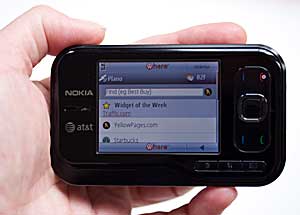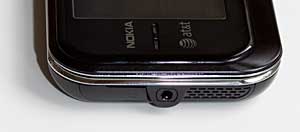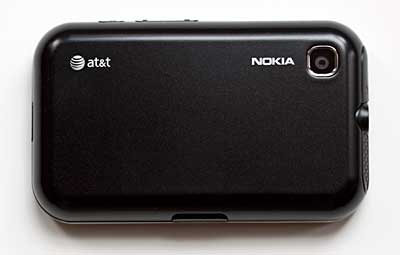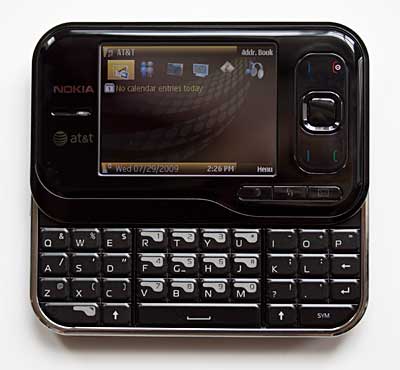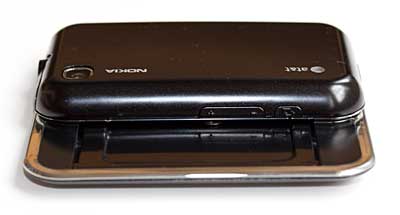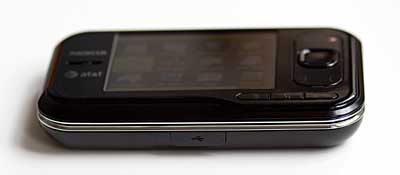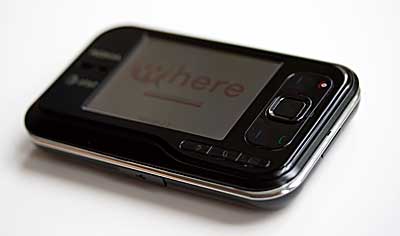
|
||||||||
Phone and Web The Nokia Surge is a quad band GSM world phone with EDGE that works on the all the world's GSM bands (850/900/1800/1900MHz). It has 3G HSDPA 3.6Mbps on AT&T's 850/1900MHz bands (it will work on EDGE overseas and when roaming on T-Mobile or in a non-AT&T 3G coverage area). Nokia's call quality and reception are in general excellent. In fact, the Surge has excellent reception on 3G and GSM, and very good quality. Calls aren't quite as sharp and clear as they are on Nokia N series and E series smartphones, but to be fair, those phones do cost more. Volume is good via earpiece and very loud with relatively little distortion via the loudspeaker located on the phone's bottom edge. The Nokia plays well with Bluetooth headsets and car kits (Nokias usually do) and we enjoyed good range and call quality with a variety of Bluetooth headsets including the Jawbone 2 and Plantronics Discovery 925. The phone comes with speed dial, call history and Nokia's voice command which isn't the most accurate.
The web browser is Nokia's usual very good webkit-based S60 browser (Safari on the iPhone is also webkit-based). It does an excellent job of rendering HTML sites, supports SSL, Javascript including advanced scripting, multiple windows and it has a virtual cursor. If you're moving up from the average feature phone, the Surge's web browser will be a big improvement, and if you're used to S60 then you'll feel comfortable with the web experience. Nokia's Messaging client is on-board. Messaging handles SMS, MMS and email messages. It works with any POP or IMAP provider as well as MS Exchange email. Messaging can handle multiple accounts, automatically check for new mail, notify you of new mail and subscribe to IMAP folders. It's not the prettiest email client on the planet, but it gets the job done. It has a setup wizard that can simplify setting up new email accounts. AT&T also includes their Java-based Mobile Email email client usually found on feature phones. It's much less capable than Nokia's Messaging and we assume AT&T includes it only for their feature phone customers who are accustomed to it. They also include OZ Instant Messaging for AIM, Yahoo and Windows Live IM.
The micro USB port lives under the rubber door on this side. Software and Syncing The Nokia Surge runs on the Symbian 9.3 OS with Nokia's S60 3rd Edition, Feature Pack 2. Like all S60 Nokia smartphones, you can sync with Outlook in Windows via USB (AT&T doesn't include a cable) and Bluetooth. Nokia usually develops iSync plugins for Mac OS X users, but they hadn't posted one on their website as of this writing. The Surge comes with Nokia's usual suite of PIM applications: contacts with myriad fields, calendar, tasks and notes. Quickoffice 4.2 is included and it can edit, read and write MS Word, Excel and PowerPoint files (but not MS Office 2007 format, which requires a paid upgrade to a newer version of Quickoffice). Adobe Reader LE is on board for PDFs, and there is a group of useful Nokia apps: calculator, unit converter, Message Reader (reads messages aloud), settings wizards, profiles and a file manager. Multimedia comes in several forms from Nokia's own music player that handles MP3, AAC and WMA files to Real Player, CV, AT&T Music (Napster) and Flash Lite 3.0. The phone works with stereo 2.5mm headsets (not included) and A2DP Bluetooth stereo headsets and headphones. There's an SDHC microSD card slot to store tunes and video. Applications are arranged in folders, as per S60's usual convention. You can move things around, create your own folders and customize the active home screen with calendar, messaging and other info along with adding 6 application/website quick launch icons. You can't remove the AT&T's horde of applications and trial-ware however. These include the usual suspects: AT&T Navigator, Yellow Pages, AT&T Mall, Mobile Banking, Mobile Email, XM Radio and many demo games. The Surge runs on the same 369MHz single core ARM family CPU used on many other recent Nokia S60 phones. The phone is generally responsive, though we experienced occasional 1 to 2 second lags a few times per day. This is more pronounced when many applications are running in the background. The phone has 128 megs of RAM (program memory) and 256 megs of flash ROM with approximately 115 megs free for you to use as storage. GPS and Camera AT&T Navigator (a $10/month service or $5/month with a data plan) offers spoken turn-by-turn directions, POIs, traffic info and re-routing and more. It does a very good job of providing cogent directions and the maps are generally quite up to date. Thanks to the Surge's loud speaker, you should have no trouble hearing directions in anything more tame than a Ferrari. The GPS uses assisted GPS to speed location fixes and the phone was very fast at getting locations and even managed inside near a window. We didn't experience lag at highway speeds, which can be a problem with phone GPS. Though not terribly large, the display is sharp and is visible outdoors (though it loses some color and contrast). For those of you who don't want spoken directions, Google Maps works perfectly on the Surge. The 2 megapixel camera has no flash and no autofocus-- so don't get too excited. The good news is that it takes very nice photos for a low spec camera, the kind that don't look grainy and atrocious when transferred to a computer. Colors are good, white balance is reasonable and there's little noise outdoors (plenty indoors). There's obvious image-twiddling and some healthy sharpening here, but Nokia does it well and the images look better for it. Video maxes out at QVGA 320 x 240 at 15 fps which isn't impressive but once again, colors and sharpness are good thanks to in-camera processing.
Battery The Nokia Surge comes with a huge battery both in size and capacity. The Nokia BP-4L Lithium Ion battery is 1500 mAh, and that's about as high capacity a battery as you'll find standard in any phone. Given the lack of WiFi, the smallish display and lack of a camera flash, this phone is the Energizer Bunny among 3G smartphones. With moderate use, it easily lasted us 2 to 3 days. The GPS eats battery fast, and CV streaming video consumes more power than any other application. Conclusion This quirky looking Nokia is indeed a good budget smartphone. We get so few S60 smartphones in the US via a carrier (most are sold as unlocked phones sans contract) that it's great to see the affordable Nokia Surge join its more expensive business-oriented big brother the Nokia E71x in AT&T's lineup. Obviously it's meant as an entry-level smartphone and upgraded messaging phone rather than a competitor to the $700 Nokia N97, but for the price it offers a heck of a lot: a great QWERTY keyboard, strong reception, good call quality and a very good GPS. And the battery life is commendable too. Pro: Very affordable smartphone. Very good QWERTY keyboard, excellent GPS. Strong reception and good voice quality. Great speakerphone. Con: Unlike the overseas version, there's no WiFi. Ugly duckling design. Stiff and noisy d-pad.Once in a while the phone lags.
Web sites: wireless.att.com, www.nokiausa.com Price: $79.99 with a 2 year contract, $279 without contract
| ||||||||
